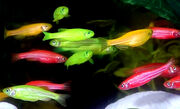
Genetic Engineering for Human Enhancement.mp4

Glofish are genetically altered to produce a "glow".
What is Genetic Engeering?
Genetic engineering is the purposeful manipulation of genetic material by scientists to create modifications to the characteristics normally seen within an organism. Although this may seem like science fiction there are many examples of this all around us. By inserting genes from sea anenomes and jellyfish, zebrafish haved been modified to glow. Many of you may have seen "Glofish" at the local pet store, and these are prime examples of genetic modification purely for human enjoyment. The marketing of these engineered pets have sparked debate, and they have been banned from sale in Calafornia due to ethical questions about their creation. However, genetic engineering is also used in farm animals. For example, goat have been modified to produce human lysozyme in their milk, which increases the nutrional value. There are also plans to clone the extinct wooly mammoth using genetic engineering technology (Ormandy, 2011). Plant modification has been happening for a long time as well. Desirable traits were selected and genetically applied to new plants to increase crop production and to create plants that were more resistant to drought or to pests (University of Nebraska, 2013). This can lead to issues though, such as pesticide resistant insects or bacteria that is resistant to the traits selected for in animals (Wolfenbarger, 2000).
Human Engineering
Today, the technology exists for parents to test gametes for disease traits such as down-syndrome and determine if the child would have a high quality of life as well as what the health risks would be for that child. There is also the technology for people to determine if they are at risk to pass on hereditary diseases such as Tray-sachs disease or sickle-cell anemia. This knowledge is beneficial to help people understand the risk of passing down a disease to their offspring. When used for improving the quality of life or for decreasing the risk of passing on genetic diseases, genetic modification seems to be beneficial, but where should the line be drawn?
Tests are being developed to determine non-disease related traits, and some already do exist. For example, parents can find out the hair and eye color of their baby (gamete), if it will be athletic, what it’s nutritional background might be, and if it will have an addictive nature. This could lead to parents selecting certain traits, which has significant moral and ethical implications. Does a parent have the right to determine the traits of another human being? What if “musicality” was selected by the parents, and the offspring grows up hating music? What would that do to the relationship between offspring and parent? Also, not everyone would have access to genetic modification, leading to a disparity between the “genetically superior” upper class and the regular human lower classes. On this same note, genetic selection could lead to people with less desirable traits feeling and being treated as inferior (Simmons, 2008).
Ormandy, E. Dale, J. Griffin, G. 2011. Genetic Engineering of Animals, Ethical Issus Including Welfare Concerns. U.S. National Library of Medicine. Can Vet J. 2011 May; 52(5): 544–550. http://www.ncbi.nlm.nih.gov/pmc/articles/PMC3078015/
Simmons, D. (2008) Genetic inequality: Human genetic engineering. Nature Education 1(1):173
'University of Nebraska. 2013. 'Overview of the Process of Plant Genetic Engineering. http://agbiosafety.unl.edu/education/summary.htm
Wolfenbarger, L. L., & Phifer, P. R. (2000). The ecological risks and benefits of genetically engineered plants. Science, 290(5499), 2088-2093